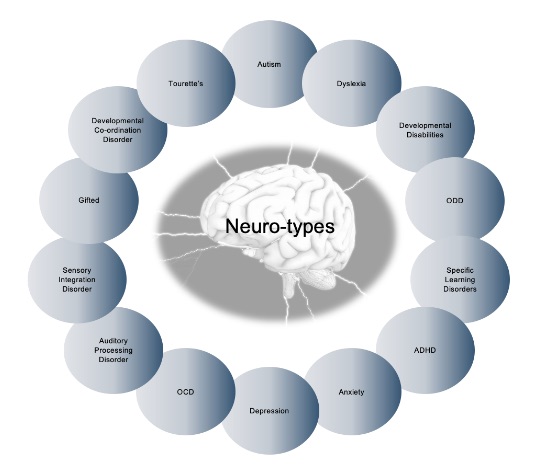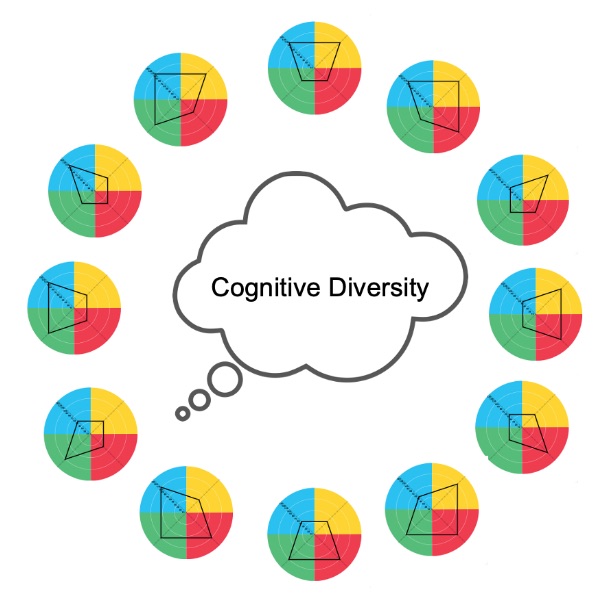We are often asked how the HBDI and Whole Brain® Thinking relate to neurodiverse groups.
To answer this question, we need to distinguish the difference between neurodiversity, neurodivergence, neuro-types and cognitive diversity.
What is Neurodiversity?
Neurodiversity refers to the way every individual’s brain works and functions differently. All individuals are neurodiverse – everyone’s brain works differently!
Neurodivergent populations are identified as those whose brain functions, reacts, responds, fires and engages differently to the neurotypical population. The neurodivergent individual has often been through a standardised diagnostic process and as a result been identified with a specific neuro-type.
Typically people attribute autism and ADHD to a neurodiverse brain – these are called neuro-types. There are many other ways a brain can be diverse. Here are some different ways a brain can manifest neurodivergence through diagnosed neurotypes:

Figure 1: Neuro-types based on neurodivergence
The neurodiverse population has been working hard to reduce the stigma nd negative perceptions individuals attribute to a neurodivergent diagnosis. Neurodivergent individuals can encounter ableism when society and individuals suggest that these people should conform to some type of norm or standard expectation. The social model of disability is a great way to think about how individuals are dis-abled within society and shares a different way to understand the neurodivergent brain.
Remember: We are all neurodiverse! However, some brains are neurodivergent and other brains are neurotypical.
What is Cognitive Diversity?
Cognitive diversity refers to the variation in individuals’ thinking styles, problem-solving approaches, perspectives, and cognitive processes. It encompasses differences in how people perceive, process, and analyse information. Cognitive diversity recognises that people have unique cognitive preferences, which can contribute to a wider range of ideas, creativity, and innovation within a group or organisation. Being cognitively diverse is one way in which our brain is neurodiverse.

Figure 2: Cognitive diversity using the HBDI as a lens
How can the HBDI® and Whole Brain® Thinking help?
The HBDI does not measure neurodiversity, but rather cognitive diversity. Every individual thinks, so in most cases the HBDI can provide a useful lens to help these Thinkers understand their cognitive diversity.
Furthermore, the HBDI is a preference-based, positively framed instrument that will identify an individual’s thinking in a helpful way. It will not compare or stereotype typical populations, but consider the whole population and the way we all process information differently to each other.
The power of the HBDI is that it provides a common language for neurodivergent and neurotypical individuals to discuss differences and similarities. Neurodivergent thinkers will gain insight from their HBDI data by understanding how their preferences play into their approach to learning, communication and life. An individual with ADHD or Autism can look at their HBDI profile as a new way to explore how they interact with the world and can apply Whole Brain® Thinking to find ways to improve their effectiveness and impact. It works in the same way that the model provides a common language that can be understood across cultures.
Whole Brain® Thinking provides neurodivergent and neurotypical populations with a lens. This can help us to bridge the gap between how our brain functions to how our brain thinks and the impact this has on communication, collaboration and working with others.
Can the HBDI be used with neurodiverse populations?
Yes! The HBDI can be completed by neurodivergent and neurotypical populations with age-appropriate language skills. Meaning that participants can understand and comprehend the questions posed in the instrument.
Can the HBDI predict neurodivergence?
No. This is not the intention behind the HBDI. The HBDI is a preference based instrument (i.e how we prefer to think). Predictive tools are normative instruments (i.e how we should think) and the HBDI does not fall into this category.
We have not done studies tracking typical preferences to various neurodivergent areas e.g. ADHD. This is because there are too many factors associated with that diagnosis for us to draw useful conclusions for research.
We do not want to imply that those with ADHD typically have a specific profile. Our approach and the philosophical legacy born out of Ned Herrmann’s early research recognised that it doesn’t work that way.
We also don’t say ‘a person with ADHD will have XYZ profile’ because neurodivergent populations also think differently to each other – not every person with ADHD thinks the same way.
We use the profile to help an individual understand and make sense of their world. It provides individuals with a positive thinking-based framework.
Here is a quote from one neurodivergent Thinker sharing what they got out of Whole Brain® Thinking and the HBDI.
“Whole Brain® Thinking and the HBDI helped me make sense of how I think and process information within my world. It did this in a non-judging way. It gave me a way to talk about my differences with colleagues in a non-threatening and positive format. It also acknowledged that I can change and adapt when I need to and helped me make sense of my experience of masking when I was younger.”
ADHD/Autistic Thinker
A message from Ann Herrmann-Nehdi:
“The HBDI measures Thinking Style Preferences. It is not a clinical assessment and it does not measure specific brain related processing differences like ADHD or Autism (neurodivergent).
We could try to see if there are specific HBDI Profiles for people with ADHD or people who are Autistic. But we don’t. The reason we don’t is this: If we do it might imply that there is an ADHD HBDI Profile or an Autistic HBDI profile. That could then imply that all Thinkers with a profile similar to that might also have a clinical diagnosis. The same applies to all neurodivergent conditions such as depression or learning disorders.
The HBDI Profile is still very helpful within the neurodivergent population as it provides a lean to help them navigate their unique situation.”
Explore how to promote Diversity and Inclusion in the Workplace throughout the following blogs:
How to Promote Diversity and Inclusion in the Workplace
Leading the Way: Enhancing Diversity and Inclusions with Autism Initiatives
If you want to learn more about how Whole Brain® Thinking and the HBDI® can help you and your organisation, have a look at how it works here or get in touch and we’ll help you find the right solution.


